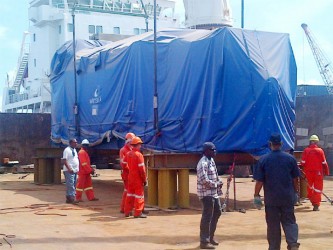The Guyana Power and Light Inc (GPL) has procured several pieces of equipment which will go towards the completion of its 26-megawatt power plant at Vreed-en-Hoop, West Bank Demerara (WBD), which it expects to be operational by next April.
Once up and running, the power plant will support the Georgetown system, and then the Berbice system once the two systems are linked. Generation capacity for Georgetown will move from 80 megawatts to 106 megawatts, which means a far more efficient and reliable electricity supply. Essequibo will not benefit from this investment, however, except for a small section of East Bank Essequibo (EBE).

Three Engines and four 8.8 megawatt generator sets along with several tanks were inspected by Prime Minister Samuel Hinds and GPL Chief Executive Officer (CEO) Bharat Dindyal on the John Fernandes Wharf yesterday morning. The equipment, according to Dindyal, will be put onto their foundations at the site in Vreed-en-Hoop over the next four to six weeks.
These are the 14th, 15th, and 16th Wartsila generating units that have been brought to the country and with each addition, Hinds said, the level of service increases. The first two units, he recalled, were brought in under the late President Cheddi Jagan.
The total investment to procure the equipment stands at US$33 million ($6.4billion) and Hinds said the amounts were garnered from tariffs paid by customers to the company.
Much of the groundwork for the transport and eventual installation of the equipment has already been made. According to Dindyal, they are about 50% complete as it relates to the construction of the needed foundations, although he said that all of the “critical” foundation work has been completed.
A lot of pile driving is needed to create a strong enough foundation and Dindyal said that they are about halfway through the pile driving of 855 piles needed for one aspect of the foundation.
In another aspect of the project, 25 piles need to be driven as part of the foundation for two storage tanks. Each of these tanks is about 300 cubic feet, thus requiring the alluded to piles to support it. Pile driving for this foundation is expected to start shortly. Dindyal, commenting on the piles needed for the project, said that the amount is necessary for several reasons.
Each of the engines that will be installed, he said, weighs about 130 tonnes once fully loaded. Additionally he said, part of the construction site is on a sea dam and therefore needs to be fortified. The site, Dindyal said, is the most challenging one to date, and he added that they have been forced to use 72 ft piles, which are the longest being used anywhere in the country.
Once in place, one of the tanks will contain diesel which will be used to flush the system when it is stopped for maintenance. Another tank will store lubrication oil, and another will hold the sludge which is produced from the processing of fuel. Yet another tank will store clean fuel while the final tank will store water which will be used for the system’s boilers, fuel processing, as well as to facilitate firefighting as needed.
GPL also hopes to commence the assembly process just as the engines are fitted to their foundations, all of which have already been completed. The power station building and the station’s control room will be the target of these works. Noting that pile driving as well as the assembly of the various buildings will run concurrently, Dindyal says they hope the different aspects of work will not hinder each other.
He also stated that BK International has been issued the contract for the construction of the wharf and fuel delivery facility that will complement the power plant’s work in Vreed-en-Hoop. The site was reportedly already visited by representatives from BK and Dindyal is hoping that the driving of concrete piles for the foundation of these structures commence soon.
Once the structures are completed, fuel ships will be able to deliver fuel to the station in Kingston, then move on to the Vreed-en-Hoop Plant before making their way to Garden of Eden.
Dindyal yesterday told reporters that the equipment will be moving from the John Fernandes Wharf at 11 am today with the high tide. They will be taken up the Essequibo River by a barge to Archie’s landing which is about two kilometres from Parika.
Before the equipment is placed on their intended foundations though, a long and tedious journey to the site must be undertaken.
To facilitate the smooth road transportation of the equipment from the landing to the site at Vreed-en-Hoop, a survey had been undertaken, targeting all roads and bridges between two locations.
Resulting from this survey a series of precautions had been decided on.
The Works Ministry had issued a contract for repairs to the section of road from the landing to Parika junction. This work, one of the precautions, has already been completed, Dindyal said.
Further precautions stemming from the survey include the procurement of a flyover bridge which will be used to provide support for bridges which may not be able to handle the weight of the equipment being moved.
Many of the bridges on the West Coast, Dindyal explained, were constructed to withstand around 50 tonnes and the equipment might just surpass this figure.
Because GPL is also concerned about power and telephone lines interrupting the transportation of the equipment, crews from the power company as well as the Guyana Telephone and Telegraph Company will tag along to resolve any such issues should the cause arise.
Dindyal said the company hopes to have the first engine in place by next Sunday at the latest. He also stated that a road has also been built from the market leading into the construction site. This will afford the trailer on which the equipment is to be transported the opportunity to park safely once it arrives.








